Time course of bilateral microglial activation in a mouse model of laser-induced glaucoma
- PMID: 32184450
- PMCID: PMC7078298
- DOI: 10.1038/s41598-020-61848-9
Time course of bilateral microglial activation in a mouse model of laser-induced glaucoma
Abstract
Microglial activation is associated with glaucoma. In the model of unilateral laser-induced ocular hypertension (OHT), the time point at which the inflammatory process peaks remains unknown. Different time points (1, 3, 5, 8, and 15 d) were compared to analyze signs of microglial activation both in OHT and contralateral eyes. In both eyes, microglial activation was detected in all retinal layers at all time points analyzed, including: i) increase in the cell number in the outer segment photoreceptor layer and plexiform layers (only in OHT eyes) from 3 d onward; ii) increase in soma size from 1 d onward; iii) retraction of the processes from 1 d in OHT eyes and 3 d in contralateral eyes; iv) increase in the area of the retina occupied by Iba-1+ cells in the nerve fiber layer/ganglion cell layer from 1 d onward; v) increase in the number of vertical processes from 1 d in contralateral eyes and 3 d in OHT eyes. In OHT eyes at 24 h and 15 d, most Iba-1+ cells were P2RY12+ and were down-regulated at 3 and 5 d. In both eyes, microglial activation was stronger at 3 and 5 d (inflammation peaked in this model). These time points could be useful to identify factors implicated in the inflammatory process.
Conflict of interest statement
The authors declare no competing interests.
Figures

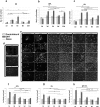

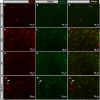

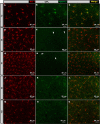
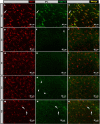
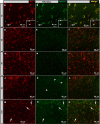
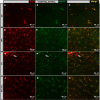
Similar articles
-
Bilateral early activation of retinal microglial cells in a mouse model of unilateral laser-induced experimental ocular hypertension.Exp Eye Res. 2018 Jun;171:12-29. doi: 10.1016/j.exer.2018.03.006. Epub 2018 Mar 9. Exp Eye Res. 2018. PMID: 29526796
-
Microglia in mouse retina contralateral to experimental glaucoma exhibit multiple signs of activation in all retinal layers.J Neuroinflammation. 2014 Jul 26;11:133. doi: 10.1186/1742-2094-11-133. J Neuroinflammation. 2014. PMID: 25064005 Free PMC article.
-
Microglial changes in the early aging stage in a healthy retina and an experimental glaucoma model.Prog Brain Res. 2020;256(1):125-149. doi: 10.1016/bs.pbr.2020.05.024. Epub 2020 Jun 16. Prog Brain Res. 2020. PMID: 32958210
-
Automatic Counting of Microglial Cells in Healthy and Glaucomatous Mouse Retinas.PLoS One. 2015 Nov 18;10(11):e0143278. doi: 10.1371/journal.pone.0143278. eCollection 2015. PLoS One. 2015. PMID: 26580208 Free PMC article.
-
IOP induces upregulation of GFAP and MHC-II and microglia reactivity in mice retina contralateral to experimental glaucoma.J Neuroinflammation. 2012 May 14;9:92. doi: 10.1186/1742-2094-9-92. J Neuroinflammation. 2012. PMID: 22583833 Free PMC article.
Cited by
-
Cilastatin as a Potential Anti-Inflammatory and Neuroprotective Treatment in the Management of Glaucoma.Int J Mol Sci. 2024 Mar 7;25(6):3115. doi: 10.3390/ijms25063115. Int J Mol Sci. 2024. PMID: 38542089 Free PMC article.
-
Effects of a New Combination of Natural Extracts on Glaucoma-Related Retinal Degeneration.Foods. 2021 Aug 15;10(8):1885. doi: 10.3390/foods10081885. Foods. 2021. PMID: 34441662 Free PMC article.
-
Evaluation of the Effectiveness of a Chronic Ocular Hypertension Mouse Model Induced by Intracameral Injection of Cross-Linking Hydrogel.Front Med (Lausanne). 2021 Mar 22;8:643402. doi: 10.3389/fmed.2021.643402. eCollection 2021. Front Med (Lausanne). 2021. PMID: 33829024 Free PMC article.
-
Exosome-based crosstalk in glaucoma pathogenesis: a focus on oxidative stress and neuroinflammation.Front Immunol. 2023 Jul 17;14:1202704. doi: 10.3389/fimmu.2023.1202704. eCollection 2023. Front Immunol. 2023. PMID: 37529047 Free PMC article. Review.
-
Multifactorial Pathogenic Processes of Retinal Ganglion Cell Degeneration in Glaucoma towards Multi-Target Strategies for Broader Treatment Effects.Cells. 2021 Jun 2;10(6):1372. doi: 10.3390/cells10061372. Cells. 2021. PMID: 34199494 Free PMC article. Review.
References
Publication types
MeSH terms
Substances
LinkOut - more resources
Full Text Sources
Other Literature Sources
Medical

